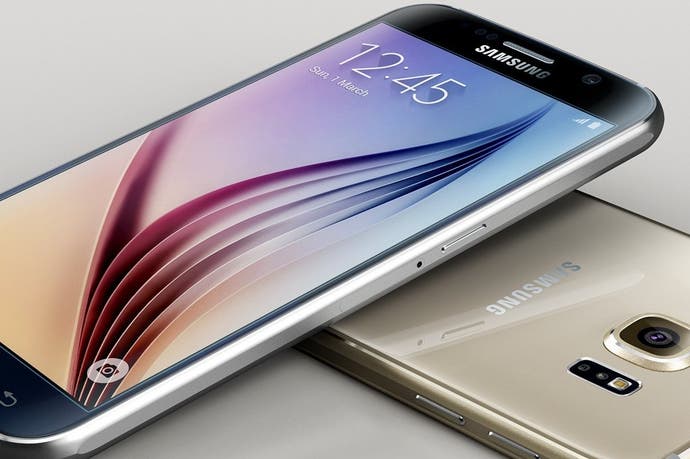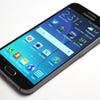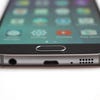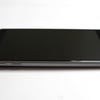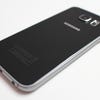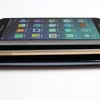Samsung Galaxy S6 review
A galaxy of difference.
Once the undisputed king of the Android smartphone market, Korean firm Samsung has had a bit of a wobble over the past few years. Its yearly Galaxy S updates have always supplied processing power in abundance, but Samsung's overzealous use of plastic and seeming inability to evolve its basic design language gained the firm some fierce critics. Of course, when sales are brisk it's relatively easy to ignore such negative feedback, but last year was something of a turning point for Samsung. The Galaxy S5 sold worse than expected and overall profits dropped as a result - unsurprisingly, the Korean giant has been spurred into action and this year's flagship offering couldn't be more different - in physical terms, at least.
Gone is the cheap plastic casing and the faux-metal trim of the S5 and in their place is a handset that could have come from the Cupertino drawing boards of Apple itself. The front and back of the Galaxy S6 are fashioned from tempered glass, while a band of machined metal runs around the edge - complete with iPhone 6-style bevel and very similar speaker grille. Enough has been written about Samsung's alleged copying of Apple's designs and there's little point in dredging that up here, suffice to say that the company has perhaps given its critics even more ammo with this slightly derivative design. Still, it's worth asking exactly how much variety we can realistically expect in this market when 99 per cent of phones are practically identical from an aesthetic standpoint, and cloning accusations aside, the S6 is a paradigm shift for Samsung as a company. Finally, it's making premium-priced handsets which actually feel premium, and that's something to be celebrated.
Granted, there are elements of the design which are irksome - the camera protrudes from the back of the phone by quite a large margin, and this makes it impossible to rest it flat on a table, unless you choose to clad it in a protective case, of course - but on the whole, this is one of the best-designed phones we've seen this year. It is complemented by an excellent 5.1-inch Super AMOLED screen that boasts a 2560x1440 resolution. That's a pixel density of 577ppi and a marked jump over the Galaxy S5's 1080p screen - although as we're rather fond of pointing out, such high pixel counts on mobile phone screens are largely pointless; it was nigh-on impossible to pick out individual pixels on the S5 anyway.
Samsung has also managed to gain an advantage over its rivals by steering away from Qualcomm tech this year. Qualcomm's Snapdragon 810 has been subject to some disappointing bad press thanks to its apparent problems with overheating, and Samsung wisely opted for its own Exynos 7420 chipset - a system-on-a-chip which is not only faster, but runs much cooler too, thanks to its 14nm fabrication process - a world first for a smartphone. This has allowed the company to make the Galaxy S6 super-thin at just 6.8mm, but has also ensured some remarkable performance. In short, this is one of the most powerful Android phones money can buy at this moment in time, but if you've been reading our Galaxy S reviews over the past few years, that sentence will be about as surprising as night following day.
We may be accustomed to Samsung's handsets providing a cutting edge spec sheet, but the raw power inside the Galaxy S6 really does supply noticeable improvements this time around. In the past we've seen phones with remarkable specifications struggle to run Android games smoothly, and the Galaxy S6 is arguably one of the first to offer stutter-free performance which wouldn't look out of place on a dedicated handheld or even a domestic home system. Real Racing 3, Asphalt 8: Airborne and NOVA 3 - traditionally titles that would be blighted by jerky frame-rates on supposed "flagship" handsets - all move along at a striking pace with no noticeable skips or judders.
And that's curious bearing in mind that the S6 is beaten on some of the GPU benchmarks below. The HTC One M9 boasts more impressive results in some areas, but in actual games, the S6 is perceptually the better, smoother performer. Perhaps it's the faster CPU set-up that helps, or maybe the 14nm processor's cooler running results in less thermal throttling. Regardless, Samsung's shift to Exynos 7420 may have been forced upon it by Qualcomm's own well-documented misfortune, but this move yields impressive results - it's clearly handy to have your very own top-tier SoC manufactured on the latest fabrication process waiting in the wings for these kind of moments, and there are few other Android handset makers that can say the same.
| Galaxy S6 | HTC One M9 | Google Nexus 6 | Galaxy S5 | iPhone 6 | iPhone 6 Plus | |
|---|---|---|---|---|---|---|
| Geekbench Single-Core | 1233 | 1087 | 1053 | 972 | 1605 | 1606 |
| Geekbench Multi-Core | 3964 | 3496 | 3081 | 2949 | 2901 | 2903 |
| 3DMark Graphics | 22954 | 34795 | 24668 | 17464 | 22824 | 24067 |
| 3DMark Physics | 17795 | 10242 | 17259 | 15541 | 9385 | 9320 |
| 3DMark IceStorm Unlimited | 21565 | 22701 | 23205 | 18524 | 17304 | 17782 |
| GFXBench T-Rex | 58.0 | 49.0 | 37.0 | 27.4 | 42.8 | 44.6 |
Sadly, the situation with software remains largely unchanged. Samsung continues to take Google's rapidly-maturing mobile OS and coat it in a highly unappealing UI. Gone is Android Lollipop's pleasing Material Design and in its place is TouchWiz, a lurid and mismatched explosion of colour and imagery that feels painfully out of date in the modern smartphone era. The situation is made even more noticeable thanks to the fact that Google's Material template is being gleefully adopted by app creators to ensure it ties in seamlessly with the core OS. Samsung's customisations mean that Material-look apps don't blend in with the rest of the UI, creating a jarring user experience where navigation and interface design fluctuates between the two design styles.
The inclusion of Themes means you can change the way things look to a certain extent - there are even officially-licensed Avengers: Age of Ultron designs, just in case you want your phone to look like it belongs to Iron Man - but generally, we prefer the refined look of Google's stock UI over such gimmicks. The removal of Lollipop's superb multi-user support - which allows you to toggle between different Google profiles on the same phone - is another black mark. Hopefully, the S7 will be freed of such problems - Samsung has listened to its critics when it comes to physical design; here's hoping that it will be equally responsive to calls for a change when it comes to software too.
While the Galaxy S6's general design is sure to elicit plenty of good will, there are some changes that have caused consternation among hardcore fans. There's no microSD card slot this year, meaning you can't upgrade the phone's core storage. This is mitigated slightly by the fact that the phone's lowest storage variant is 32GB, and Samsung is offering a 128GB version this time around. It's also worth noting that as part of an agreement with Microsoft, the Galaxy S6 ships with OneDrive support as standard and offers 100GB of space for photos and other files. Canny use of this - along with other cloud storage services, such as Google Drive and Dropbox - means that the lack of a MicroSD card slot is less of an issue, but it's a shame such a useful feature has been expunged. It is also worth pointing out that all the cloud storage in the world means little if you have no way of connecting to it - a microSD card doesn't need an internet connection.
Another drawback is the lack of a removable battery. To create such a thin and attractive design - and one fashioned from premium components, as well - Samsung has had to revert to a totally sealed unit. That means you can't swap out the battery for a spare when you're on the road - something that we've never considered doing personally, but know full well is a deal-breaker for many Android users. Again, this is a feature accommodated by the Galaxy S range for many years now, so the dismay generated by this move is understandable.
Water resistance is another Galaxy S5 feature that has been consigned to the scrapheap, along with the micro USB 3.0 port. To make up for these drawbacks Samsung has equipped the S6 with a wide range of charging options. Wireless charging is included - to tie in with the Korean company's deal with furniture maker IKEA, which will see wireless charging ports installed into sofas and the like - as is Samsung's own brand of fast-charging. The bundled power supply fully charges the phone in around an hour, and the S6 supports Qualcomm's 2.0 charging tech, too - we tested it with the power supply that shipped with the Nexus 6.
The only fly in the ointment here is that the Galaxy S6 has a smaller battery than the S5 - 2550 mAh compared to the 2800 mAh one found in last year's model - and when you take into account the higher resolution screen and more powerful processor, this predictably results in less stamina. The processor's drop to 14nm can be expected to save power, but in the case of the S6, there's not quite enough juice to maintain the same overall battery life. When you consider that the Galaxy S5 hardly had the most notable staying power, it's something of disappointment to find out that its successor is even less likely to get you through an entire day. During our review we noticed that the phone was running on empty by around 8pm after a full day of normal, everyday use - of course the convenience of wireless charging and the ability to fast-charge in short bursts does make this a little easier to swallow, but if stamina is one of your prime concerns - and you like having a spare power cell in your bag on long trips - you could see this as something of a downgrade.
Thankfully, Samsung has kept some of the S5's better ideas and improved them almost beyond recognition. NFC and the heart rate monitor are present and correct, but it's the fingerprint scanner that is most improved. The scanner on the S6 - located on the home button - is a gigantic step forwards compared to the one that shipped on last year's model. With the S5 you had to swipe your finger across the sensor to unlock the device, and this predictably offered up more margin for error - it was an exercise in trial-and-error, and awkward to achieve when holding the phone with one hand. As a result, many owners refused to enable it, making one of the handset's tentpole features superfluous. We're pleased to report that the sensor on the S6 doesn't need a swiping motion and offers a quick and thoroughly accurate means of unlocking the handset. Multiple fingerprints can be stored in its memory, and while the initial setup process is prolonged and occasionally irksome, once successfully completed it offers a hassle-free means of securing the phone.
Elsewhere, that aforementioned bulky camera proves its worth by offering the kind of quality that Apple would be proud of. Ever since the first iPhone, Apple has prided itself on its mobile cameras - they're faster to snap and generally offer superior results when compared to practically any handset out there. After the disappointment of the Nexus 6's camera - which suffers from the trademark slow shutter speed which seems to blight all of Google's Nexus phones - we were very impressed by the 16-megapixel sensor on the Galaxy S6.
Images are detailed, colourful and offer excellent contrast. Samsung's revised camera software is also much better than the stock Android app, boasting the usual selection of shooting modes - panoramic, slow-motion and many more which can be download from Samsung's own app store - as well as a "professional" mode, allowing you to tinker with elements like white balance, ISO and metering. These go way beyond what the standard Android camera app offers, and should go a long way to pleasing budding photographers who like more control over their snaps. Video recording is just as impressive, with UHD resolution (3840x2160 pixels) supported at 30fps and 1920x1080p recording at 60fps.




Samsung Galaxy S6: the Digital Foundry verdict
Samsung is still yet to make the perfect Android phone - but then the same could be said of every manufacturer operating in this crowded, cut-throat sector, including Google itself. The Galaxy S6 certainly isn't the best phone it could possibly be - TouchWiz is still an annoyance, and the reduced stamina and lack of expandable storage will diminish its standing in the eyes of serious Android users - but it nevertheless represents a massive, confident forward stride for the Korean firm.
However, on the plus side, it's good to see that Samsung has finally shaken off its obsession with plastic and crafted a handset that feels as good as it looks. The Exynos SoC is another big success here; by going with its own homegrown tech, Samsung has neatly sidestepped the throttling and heat issues which plague the majority of its Android rivals whose leading phones are equipped with the Snapdragon 810. The 14nm technology doesn't translate into the battery life win we were hoping for though, and the smaller battery doesn't help either.
However, the fact remains that the premium quality and processing performance really are very impressive. Roll in an exemplary camera, fantastic AMOLED screen, good call quality and plenty of charging options - including wireless and fast charging - and you've got a pretty impressive package. It was never going to take much to trump the disappointing S5, but Samsung has gone the extra mile here. Fingers are firmly crossed that the Korean giant can align its new design sensibilities with better software next year.
Review unit kindly provided by www.mobilefun.co.uk.
